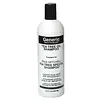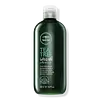What's inside
What's inside
 Key Ingredients
Key Ingredients

 Benefits
Benefits

 Concerns
Concerns

 Ingredients Side-by-side
Ingredients Side-by-side

Water
Skin ConditioningSodium Laureth Sulfate
CleansingSodium Lauryl Sulfate
CleansingCocamide Mipa
EmulsifyingGlycerin
HumectantParfum
MaskingPEG-150 Distearate
EmulsifyingDipropylene Glycol
HumectantCocamidopropyl Betaine
CleansingGlycol Stearate
EmollientSodium Chloride
MaskingDiazolidinyl Urea
PreservativeBisamino PEG/PPG-41/3 Aminoethyl Pg-Propyl Dimethicone
Melaleuca Alternifolia Leaf
AbrasiveMenthol
MaskingPanthenol
Skin ConditioningPolyquaternium-7
Tetrasodium EDTA
Citric Acid
BufferingSodium Benzoate
MaskingIodopropynyl Butylcarbamate
PreservativeLaminaria Digitata Extract
Skin ProtectingHedychium Coronarium Root Extract
MaskingRosmarinus Officinalis Leaf
Skin ConditioningSimmondsia Chinensis Seed Cera
EmollientCI 19140
Cosmetic ColorantAloe Barbadensis Leaf Juice
Skin ConditioningLeuconostoc/Radish Root Ferment Filtrate
AntimicrobialChamomilla Recutita Flower
Skin ConditioningBlue 1 Lake
Cosmetic ColorantLimonene
PerfumingLinalool
PerfumingWater, Sodium Laureth Sulfate, Sodium Lauryl Sulfate, Cocamide Mipa, Glycerin, Parfum, PEG-150 Distearate, Dipropylene Glycol, Cocamidopropyl Betaine, Glycol Stearate, Sodium Chloride, Diazolidinyl Urea, Bisamino PEG/PPG-41/3 Aminoethyl Pg-Propyl Dimethicone, Melaleuca Alternifolia Leaf, Menthol, Panthenol, Polyquaternium-7, Tetrasodium EDTA, Citric Acid, Sodium Benzoate, Iodopropynyl Butylcarbamate, Laminaria Digitata Extract, Hedychium Coronarium Root Extract, Rosmarinus Officinalis Leaf, Simmondsia Chinensis Seed Cera, CI 19140, Aloe Barbadensis Leaf Juice, Leuconostoc/Radish Root Ferment Filtrate, Chamomilla Recutita Flower, Blue 1 Lake, Limonene, Linalool
Water
Skin ConditioningSodium Laureth Sulfate
CleansingSodium Lauryl Sulfate
CleansingCocamide Mipa
EmulsifyingParfum
MaskingCocamidopropyl Betaine
CleansingPanthenol
Skin ConditioningMelaleuca Alternifolia Leaf Oil
AntioxidantMenthol
MaskingHedychium Coronarium Flower/Leaf/Stem Extract
Skin ConditioningTriticum Vulgare Germ Oil
EmollientAlgae Extract
EmollientSimmondsia Chinensis Leaf Extract
HumectantAloe Barbadensis Leaf Extract
EmollientAnthemis Nobilis Flower Extract
MaskingRosmarinus Officinalis Leaf Extract
AntimicrobialGlycerin
HumectantOleamidopropyl Betaine
CleansingPropylene Glycol
HumectantGlycol Stearate
EmollientPEG-150 Distearate
EmulsifyingCitric Acid
BufferingTetrasodium EDTA
Polyquaternium-7
Bisamino PEG/PPG-41/3 Aminoethyl Pg-Propyl Dimethicone
PEG-12 Dimethicone
Skin ConditioningMethylchloroisothiazolinone
PreservativeMethylisothiazolinone
PreservativeMagnesium Chloride
Magnesium Nitrate
Limonene
PerfumingLinalool
PerfumingCitronellol
PerfumingCI 42090
Cosmetic ColorantCI 19140
Cosmetic ColorantWater, Sodium Laureth Sulfate, Sodium Lauryl Sulfate, Cocamide Mipa, Parfum, Cocamidopropyl Betaine, Panthenol, Melaleuca Alternifolia Leaf Oil, Menthol, Hedychium Coronarium Flower/Leaf/Stem Extract, Triticum Vulgare Germ Oil, Algae Extract, Simmondsia Chinensis Leaf Extract, Aloe Barbadensis Leaf Extract, Anthemis Nobilis Flower Extract, Rosmarinus Officinalis Leaf Extract, Glycerin, Oleamidopropyl Betaine, Propylene Glycol, Glycol Stearate, PEG-150 Distearate, Citric Acid, Tetrasodium EDTA, Polyquaternium-7, Bisamino PEG/PPG-41/3 Aminoethyl Pg-Propyl Dimethicone, PEG-12 Dimethicone, Methylchloroisothiazolinone, Methylisothiazolinone, Magnesium Chloride, Magnesium Nitrate, Limonene, Linalool, Citronellol, CI 42090, CI 19140
 Reviews
Reviews

Ingredients Explained
These ingredients are found in both products.
Ingredients higher up in an ingredient list are typically present in a larger amount.
Bisamino PEG/PPG-41/3 Aminoethyl Pg-Propyl Dimethicone is a type of silicone.
CI 19140 is also known as Tartrazine. Tartrazine is a synthetic dye used in cosmetics, foods, and medicine to add a yellow color.
Tartrazine is created from petroleum and is water-soluble.
Some people may experience allergies from this dye, especially asthmatics and those with an aspirin intolerance.
Learn more about CI 19140Citric Acid is an alpha hydroxy acid (AHA) naturally found in citrus fruits like oranges, lemons, and limes.
Like other AHAs, citric acid can exfoliate skin by breaking down the bonds that hold dead skin cells together. This helps reveal smoother and brighter skin underneath.
However, this exfoliating effect only happens at high concentrations (20%) which can be hard to find in cosmetic products.
Due to this, citric acid is usually included in small amounts as a pH adjuster. This helps keep products slightly more acidic and compatible with skin's natural pH.
In skincare formulas, citric acid can:
While it can provide some skin benefits, research shows lactic acid and glycolic acid are generally more effective and less irritating exfoliants.
Most citric acid used in skincare today is made by fermenting sugars (usually from molasses). This synthetic version is identical to the natural citrus form but easier to stabilize and use in formulations.
Read more about some other popular AHA's here:
Learn more about Citric AcidWe don't have a description for Cocamide Mipa yet.
Cocamidopropyl Betaine is a fatty acid created by mixing similar compounds in coconut oil and dimethylaminopropylamine, a compound with two amino groups.
This ingredient is a surfactant and cleanser. It helps gather the dirt, pollutants, and other impurities in your skin to be washed away. It also helps thicken a product and make the texture more creamy.
Being created from coconut oil means Cocamidopropyl Betaine is hydrating for the skin.
While Cocamidopropyl Betaine was believed to be an allergen, a study from 2012 disproved this. It found two compounds in unpure Cocamidopropyl Betaine to be the irritants: aminoamide and 3-dimethylaminopropylamine. High-grade and pure Cocamidopropyl Betaine did not induce allergic reactions during this study.
Learn more about Cocamidopropyl BetaineGlycerin is already naturally found in your skin. It helps moisturize and protect your skin.
A study from 2016 found glycerin to be more effective as a humectant than AHAs and hyaluronic acid.
As a humectant, it helps the skin stay hydrated by pulling moisture to your skin. The low molecular weight of glycerin allows it to pull moisture into the deeper layers of your skin.
Hydrated skin improves your skin barrier; Your skin barrier helps protect against irritants and bacteria.
Glycerin has also been found to have antimicrobial and antiviral properties. Due to these properties, glycerin is often used in wound and burn treatments.
In cosmetics, glycerin is usually derived from plants such as soybean or palm. However, it can also be sourced from animals, such as tallow or animal fat.
This ingredient is organic, colorless, odorless, and non-toxic.
Glycerin is the name for this ingredient in American English. British English uses Glycerol/Glycerine.
Learn more about GlycerinGlycol Stearate comes from stearic acid and ethylene glycol.
It is a creamy wax used to stabilize ingredients as an emulsifier. Glycol stearate also contains emollient properties. Emollients sit on top of the skin to prevent moisture from escaping.
This ingredient may not be Malassezia folliculitis, or fungal-acne safe.
Learn more about Glycol StearateLimonene is a fragrance that adds scent and taste to a formulation.
It's found in the peel oil of citrus fruits and other plants such as lavender and eucalyptus. The scent of limonene is generally described as "sweet citrus".
Limonene acts as an antioxidant, meaning it helps neutralize free radicals.
When exposed to air, oxidized limonene may sensitize the skin. Because of this, limonene is often avoided by people with sensitive skin.
The term 'fragrance' is not regulated in many countries. In many cases, it is up to the brand to define this term. For instance, many brands choose to label themselves as "fragrance-free" because they are not using synthetic fragrances. However, their products may still contain ingredients such as essential oils that are considered a fragrance.
Learn more about LimoneneLinalool is a fragrance and helps add scent to products. It's derived from common plants such as cinnamon, mint, citrus, and lavender.
Like Limonene, this ingredient oxidizes when exposed to air. Oxidized linalool can cause allergies and skin sensitivity.
This ingredient has a scent that is floral, spicy tropical, and citrus-like.
Learn more about LinaloolMenthol is a compound found in mint plants, such as peppermint. In its pure form, it is a clear crystalline substance.
Menthol is known for its cooling sensation; however, the cooling is actually from your skin being sensitized. Menthol can worsen rosacea. We recommend speaking with a professional if you have concerns.
Menthol also has antimicrobial properties.
Learn more about MentholPanthenol is a common ingredient that helps hydrate and soothe the skin. It is found naturally in our skin and hair.
There are two forms of panthenol: D and L.
D-panthenol is also known as dexpanthenol. Most cosmetics use dexpanthenol or a mixture of D and L-panthenol.
Panthenol is famous due to its ability to go deeper into the skin's layers. Using this ingredient has numerous pros (and no cons):
Like hyaluronic acid, panthenol is a humectant. Humectants are able to bind and hold large amounts of water to keep skin hydrated.
This ingredient works well for wound healing. It works by increasing tissue in the wound and helps close open wounds.
Once oxidized, panthenol converts to pantothenic acid. Panthothenic acid is found in all living cells.
This ingredient is also referred to as pro-vitamin B5.
Learn more about PanthenolParfum is a catch-all term for an ingredient or more that is used to give a scent to products.
Also called "fragrance", this ingredient can be a blend of hundreds of chemicals or plant oils. This means every product with "fragrance" or "parfum" in the ingredients list is a different mixture.
For instance, Habanolide is a proprietary trade name for a specific aroma chemical. When used as a fragrance ingredient in cosmetics, most aroma chemicals fall under the broad labeling category of “FRAGRANCE” or “PARFUM” according to EU and US regulations.
The term 'parfum' or 'fragrance' is not regulated in many countries. In many cases, it is up to the brand to define this term.
For instance, many brands choose to label themselves as "fragrance-free" because they are not using synthetic fragrances. However, their products may still contain ingredients such as essential oils that are considered a fragrance by INCI standards.
One example is Calendula flower extract. Calendula is an essential oil that still imparts a scent or 'fragrance'.
Depending on the blend, the ingredients in the mixture can cause allergies and sensitivities on the skin. Some ingredients that are known EU allergens include linalool and citronellol.
Parfum can also be used to mask or cover an unpleasant scent.
The bottom line is: not all fragrances/parfum/ingredients are created equally. If you are worried about fragrances, we recommend taking a closer look at an ingredient. And of course, we always recommend speaking with a professional.
Learn more about ParfumPeg-150 Distearate is an emulsifier and thickening agent. It is created from stearic acid.
As an emulsifier, peg-150 distearate helps other ingredients dissolve. This helps prevent ingredient separation.
This ingredient may not be Malassezia folliculitis, or fungal-acne safe.
Learn more about PEG-150 DistearatePolyquaternium-7 is a light to clear colored liquid. It is commonly found in haircare products for its film-forming and anti-static properties.
According to a manufacturer, it is a non-paraben and specially developed for negatively charged surfactant systems. This makes it a great hairstyle holder and helps to improve wet hair detangling without adding buildup.
Sodium Laureth Sulfate (SLES) is a foaming, cleansing, and emulsifying ingredient. It is created from palm kernel oil or coconut oil. SLES is not the same as sodium lauryl sulfate. It is much milder and less likely to irritate.
SLES helps create foam in personal products. It also prevents ingredients from separating, helping to elongate the shelf life.
Sodium Laureth Sulfate is a type of sulfate. It can be drying. We recommend speaking with a professional about using this ingredient if you have concerns.
Learn more about Sodium Laureth SulfateSodium Lauryl Sulfate (SLS) is a sulfate with surfactant properties.
The surfactant property make it a great foam creator and cleansing agent. Surfactants help bind ingredients that normally do not mix.
Some studies have shown skin irritation due to prolonged SLS use.
Sodium Laureth Sulfate (SLES) is a milder version of SLS.
Learn more about Sodium Lauryl SulfateTetrasodium EDTA is the salt formed from neutralizing ethylenediamine tetraacetic acid with sodium hydroxide. It is a chelating agent and used to prevent metal ions from binding to other ingredients. This helps keep the product and ingredients stable.
Tetrasodium EDTA comes as a white solid and is soluble in water.
Water. It's the most common cosmetic ingredient of all. You'll usually see it at the top of ingredient lists, meaning that it makes up the largest part of the product.
So why is it so popular? Water most often acts as a solvent - this means that it helps dissolve other ingredients into the formulation.
You'll also recognize water as that liquid we all need to stay alive. If you see this, drink a glass of water. Stay hydrated!
Learn more about Water